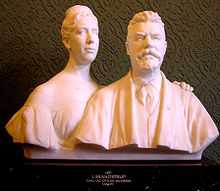Carl Jacobsen

Carl Christian Hillman Jacobsen (2 March 1842 – 11 January 1914) was a Danish brewer, art collector and philanthropist, the son of J. C. Jacobsen, who founded the brewery Carlsberg and named it after him. His wife (see picture) Ottilia Marie Jacobsen, née Stegmann (3 October 1854 - 20 July 1903), whom he met during a business trip to Edinburgh in Scotland later marrying in Copenhagen on 24 September 1874),[1] was almost as famous as himself within the contemporary arts community in Denmark. She was the daughter of the Danish grain merchant Conrad Stegmann and wife Louise Marie, née Brummer.
Career
First Carl worked for his father but partly because of his conflicts between them, he founded his own brewery in 1882. It was first named Valby Brewery but upon his father's approval changed its name to Ny Carlsberg (English: New Carlsberg], while his father's enterprise at the same occasion changed its name to Gammel Carlsberg [English: Old Carlsberg]. At his father's death, Carl Jacobsen did not at once obtain the leading post of the old brewery. Instead his father left it to the Carlsberg Foundation which he had founded in 1876, later the two Carlsbergs merged and from 1906 Carl was CEO of Carlsberg. As a "sole ruler" he carried on his father’s work.
Artistic interest and philanthropy
Carl Jacobsen did not share his father's political commitment, though like him he was an eager cultural enthusiast known for his interest in Greek and classical art and his engagement led to the founding of the Ny Carlsberg Glyptotek in 1897, an art museum mainly based upon his Antique collections still regarded as one of the most important Danish art museums.
Carl Jacobsens interest in the arts is also demonstrated by his brewery. He employed the leading Danish architects of the time, mainly Vilhelm Dahlerup, and the buildings were designed with great care to detail as seen in the Winding Chimney.
Often taking part in discussions of architecture of Copenhagen, he paid for the restoration of several churches and public buildings and was also behind the 1913 sculpture of The Little Mermaid.
Though often preoccupied with his cultural interests, Carl was a shrewd and visionary businessman and initiated the transition of Carlsberg from a local Copenhagen brewery to the multinational conglomerate that it is today.
References
- ↑ Minister book Garnisons Kirke, København
Bibliography
- Kristof Glamann: Beer and Marble. Carl Jacobsen of New Carlsberg. Copenh. 1996.
| Wikimedia Commons has media related to Carl Jacobsen. |
| ||||||||||||||||||||||
|